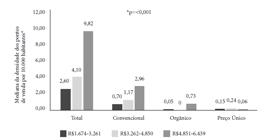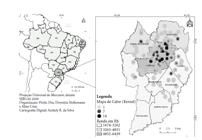Abstract
Greater availability of fruit and vegetables (FV) may enhance the consumption of these food products. This study sought to investigate demographic and household income inequalities in the spatial distribution of FV in the city of Curitiba, State of Paraná. A total of 106 FV outlets were listed in the 10 administrative regions on the City Hall Supply Department website. Data on population and household income of the administrative regions were obtained from the 2010 Demographic Census. The food sale outlets were identified, and subsequently analyzed for the correlation between the regions by the Moran index. A total of 407 food stands were evaluated in 103 public facilities that commercialized FV. A concentration of street food markets in the central areas of the city, with a global Moran index of 0.99, was observed. In the regions, only one did not have an outlet (Tatuquara). There was a higher concentration of outlets in the higher-income regions (9.82/10,000 inhabitants) compared to those with the lower income regions (2.60/10,000 inhabitants) (p <0.001). Inequities were observed in the supply and in the quality of FV available in public facilities in lower-income regions, which should be considered by administrators when planning distribution in these locations.
Key words:
Healthy eating; Spatial distribution; Socioeconomic factors; Public policies

 Thumbnail
Thumbnail
 Thumbnail
Thumbnail
 Thumbnail
Thumbnail
 Thumbnail
Thumbnail
 *Tercis de renda e densidade dos pontos de venda nas regionais, Teste de Tendência Linear Fonte: Elaborado pelos autores.
*Tercis de renda e densidade dos pontos de venda nas regionais, Teste de Tendência Linear Fonte: Elaborado pelos autores.
 Fonte: Elaborado pelos autores.
Fonte: Elaborado pelos autores.
 Legenda: Valores significativos p≤0,05 destacados em negrito, dados pelo índice de Moran local (LISA).Fonte: Elaborado pelos autores.
Legenda: Valores significativos p≤0,05 destacados em negrito, dados pelo índice de Moran local (LISA).Fonte: Elaborado pelos autores.
 Legenda: Valores significativos p≤0,05 destacados em negrito, dados pelo índice de Moran local (LISA). Fonte: Elaborado pelos autores.
Legenda: Valores significativos p≤0,05 destacados em negrito, dados pelo índice de Moran local (LISA). Fonte: Elaborado pelos autores.